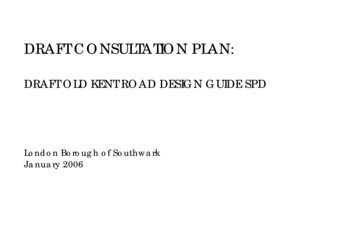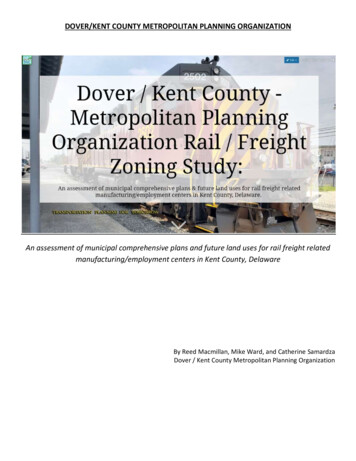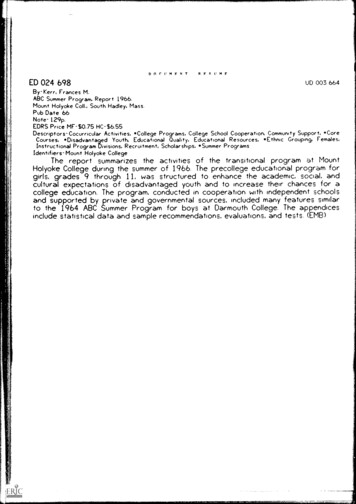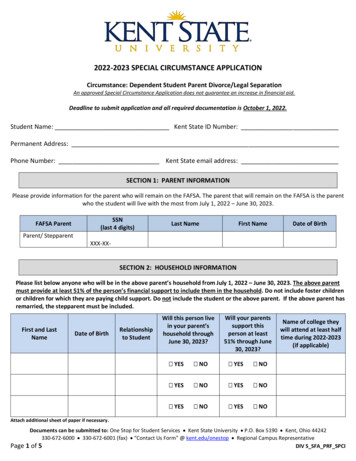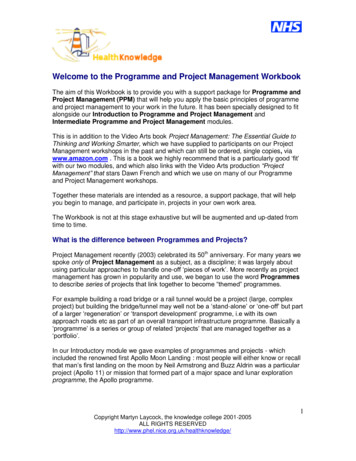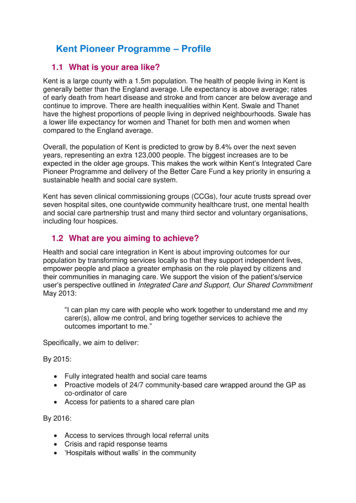
Transcription
Kent Pioneer Programme – Profile1.1 What is your area like?Kent is a large county with a 1.5m population. The health of people living in Kent isgenerally better than the England average. Life expectancy is above average; ratesof early death from heart disease and stroke and from cancer are below average andcontinue to improve. There are health inequalities within Kent. Swale and Thanethave the highest proportions of people living in deprived neighbourhoods. Swale hasa lower life expectancy for women and Thanet for both men and women whencompared to the England average.Overall, the population of Kent is predicted to grow by 8.4% over the next sevenyears, representing an extra 123,000 people. The biggest increases are to beexpected in the older age groups. This makes the work within Kent’s Integrated CarePioneer Programme and delivery of the Better Care Fund a key priority in ensuring asustainable health and social care system.Kent has seven clinical commissioning groups (CCGs), four acute trusts spread overseven hospital sites, one countywide community healthcare trust, one mental healthand social care partnership trust and many third sector and voluntary organisations,including four hospices.1.2 What are you aiming to achieve?Health and social care integration in Kent is about improving outcomes for ourpopulation by transforming services locally so that they support independent lives,empower people and place a greater emphasis on the role played by citizens andtheir communities in managing care. We support the vision of the patient’s/serviceuser’s perspective outlined in Integrated Care and Support, Our Shared CommitmentMay 2013:“I can plan my care with people who work together to understand me and mycarer(s), allow me control, and bring together services to achieve theoutcomes important to me.”Specifically, we aim to deliver:By 2015: Fully integrated health and social care teamsProactive models of 24/7 community-based care wrapped around the GP asco-ordinator of careAccess for patients to a shared care planBy 2016: Access to services through local referral unitsCrisis and rapid response teams‘Hospitals without walls’ in the community
A continued focus on enablement, admission avoidance and crisisinterventionBy 2018 we want to achieve an integrated system that is sustainable for the futureand crosses the boundaries between primary, community, hospital and social carewith services working together, along with voluntary and private sector organisations.There will be improved outcomes for our population, drawing on the ‘Kent Pound’across the entire health and social care economy.1.3 What have been the highlights of your first year? Developing a programme of proactive careSetting up an integrated rapid response serviceSetting up an integrated discharge teamExtending the working hours and co-location at the weekends of our healthand social care co-ordination teamIntergenerational work towards dementia-friendly communitiesA shadow tariff and capitation budgetLeadership development to support local leadersDeveloping a methodology for self care1.4 Details of the yearIn South Kent Coast we had set up a programme of proactive care for people withlong-term conditions supported by a multi-disciplinary team (MDT) which hasachieved reductions in A&E attendance and admissions, patient-reportedimprovements and savings of over 224,000. See case study: Embedding proactivereablement care.An integrated enhanced rapid response service for West Kent began in November2013 to avoid unnecessary hospital admissions and support people on dischargefrom hospital. The service is already achieving results. See case study: Developingan enhanced integrated rapid response service.Since October 2013, a multi-disciplinary integrated discharge team has been up andrunning in North Kent. The team aims to reduce admissions, ensure patients’ needsare proactively managed to reduce their length of stay and to enable patients whosemedical conditions are stable to leave hospital in a timely manner. There is evidencethat the team’s work is reducing emergency admissions, A&E waiting times,improving access to mental health assessments and avoiding permanent care forpeople supported. See case study: Operating an integrated discharge team.Health and social care co-ordinators are based in Canterbury and West Kent CCGs.They help co-ordinate activity around MDTs and between GPs and communityservices. In Canterbury the current service has had over 3,363 contacts, with 1,920A&E attendances avoided and 1,443 admissions avoided over the year January2014 – January 2015. The cost saving to the local health economy has beenidentified as over 200k. From April 2014 the service moved to extended workinghours, included co-locating at the local acute site at weekends.
We have continued our work to build dementia-friendly communities – including workwith local communities through intergenerational activity between schools and carehomes with people living with dementia. This includes the creation of dementiadiaries, connecting people through iPads and training workshops for paramedics.As an early implementer of the Year of Care approach to funding, Kent has outlinedwhat could be achieved through delivering whole-system transformation. We haveestablished a shadow tariff and annual risk-adjusted capitation budget, based onpeople’s levels of health care need (as opposed to what specific diseases they have)Year two of the pilot started at the end of the first quarter of 2013. Work hascontinued with the group of patients who had been identified in the first audit phase,to build up a longer-term picture of their care.The Kent Innovation Hub was launched in December 2013 as a means of connectingstakeholders across Kent on the issues of integration: www.kent.gov.uk/pioneer.In relation to information governance, we are mapping data sources for sharedsystem-wide intelligence and will be continuing the development of shared data forcommissioningWe have been working on ensuring that our workforce is fit for purpose in takingforward our integration work – this includes the innovative development of‘leadership of place’, supporting local leaders within services, teams and on the frontline.“Since I have been part of the Health and Social Care Integrated Programmepathways work over the last year, I now take a different approach by thinking throughthe options and alternatives to hospital care – when in the past we sometimes tookpeople to hospital when they didn’t need to go.”West Kent paramedic1.5 What has been the most exciting aspect?Kent’s approach to integration is about local delivery and, as it is a very large county,we are proud of having brought and kept all the stakeholders together in ourIntegration Pioneer Steering Group and having developed shared aims andobjectives. We believe we have kept the momentum going for change focused onreal outcomes for patients and services users because of the commitment of thevery senior steering group members and because of regular communication with allthose involved in the work programme.We are aware that other areas may have found it challenging to engage with GPs,ensuring they are involved in developing the vision and plans for new models ofcare. We are very fortunate, therefore, that our steering group is chaired by a GPwho is really focused on the vision, is passionate about it and is a strong advocatewith other GPs.1.6 What has been the most challenging aspect?
Bringing everyone together – it’s challenging as well as exciting! We have had towork hard at building relationships between multiple partners.As with other areas, it has been challenging to sort out information governancearrangements and we are hoping for some assistance nationally with this issue.We have also requested support with arranging insurance for nurses; if a nurse isnot working in a setting that is covered by crown indemnity or a traditional GPpractice working under vicarious liability, they are very expensive to insure. Thegreater the level of independent working and decision-making, the higher the cost.This is a ‘block’ for going forward if we are to successfully implement morecommunity based services.1.7 What are you planning to do next year? Integration Pioneer Steering Group will be doing further work aroundleadership and developing work in relation to the models of care in the NHSFive Year Forward ViewOur Better Care Fund work will be very much about embedding localimplementation – establishing different models of neighbourhood care teamsetcLooking at evaluation, furthering our connections with European partnersbenefiting from the experience with similar issues across Europe: bringing thebest practices and lessons learned to Kent through our (CASA) Consortiumfor Assistive Solutions Adoption ProgrammeKent Innovation Hub is at the forefront of the collaboration between Kent andits European partners to improve:o Synergies between social and healthcare services towards integratedcommissioning and provisiono Business modelling and proper monitoring by engaging industry andbusinesso Raising the awareness of the European institutions and stakeholders ofKent’s successes and identifying opportunities for replicationThe Innovation Hub has the capacity to develop a number of policyinstruments and measures bringing together synergies between public/privatepartnerships, research and development and knowledge transfer, venturecapital funding, care providers and the business sector in the county andacross EuropeImplementing our shared care plan modelThe CCGs will be developing contracting and payment models, building onthe work we have already done towards capitated budgets1.8 What is your advice for areas starting on their ownintegration journey? Build in good communication; talk to each other regularly and ensure that youare all sharing the same objectivesKeep focused on what this is about – improved outcomes for peopleInvolve users and carers in the design and development of services or change
In developing our Innovation Hub to support integrated working, we used a numberof motivational statements. We have found the following to be a genuine reflection ofthe reality of bringing together individuals and organisations to collaborate intransforming services:“Innovations do not just happen – they are a team effort. Most successful innovationoccurs at the boundaries of organisations and industries where the problems andneeds of users and the potential of technologies are linked together in a creative andcollaborative process that challenges both.”Contact: The Pioneer TeamEmail: Pioneers@Kent.gov.uk
Kent Pioneer Programme - Profile 1.1 What is your area like? Kent is a large county with a 1.5m population. The health of people living in Kent is generally better than the England average. Life expectancy is above average; rates of early death from heart disease and stroke and from cancer are below average and continue to improve.
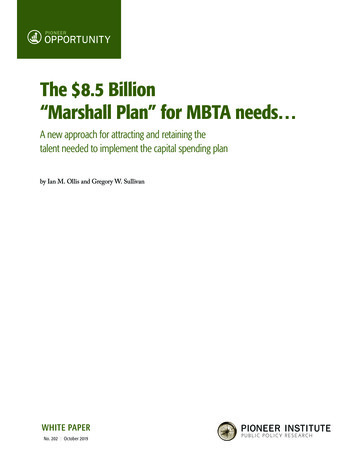
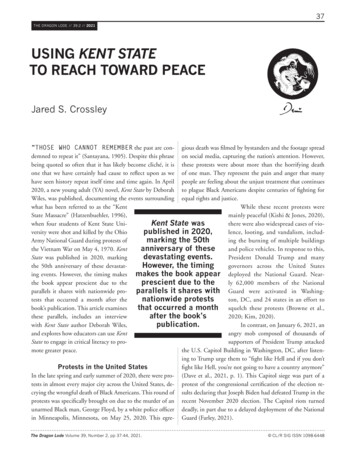
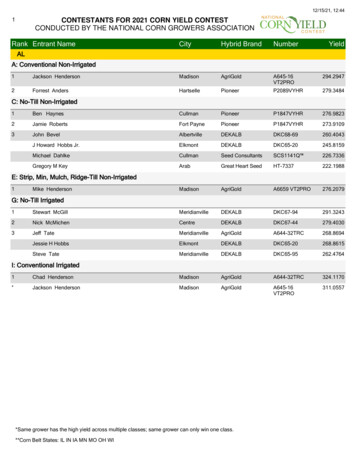
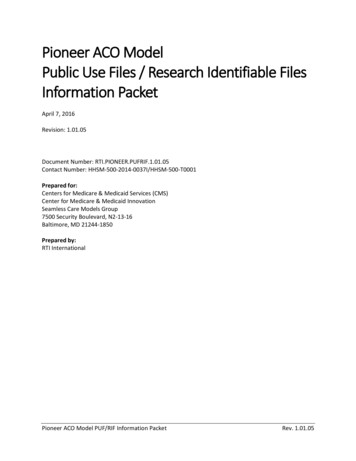
![Z W ] } v ] ( ( nce completed, W ] } v W l P ] v P t r õ W ] } v W l P .](/img/56/pioneer-new-client-welcome-2021.jpg)

